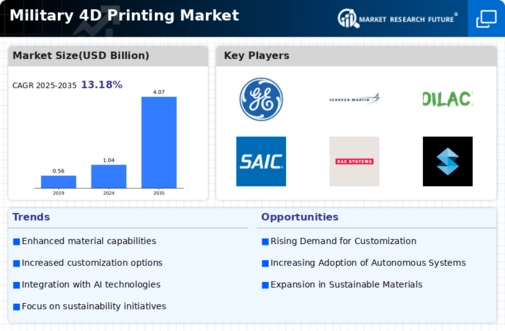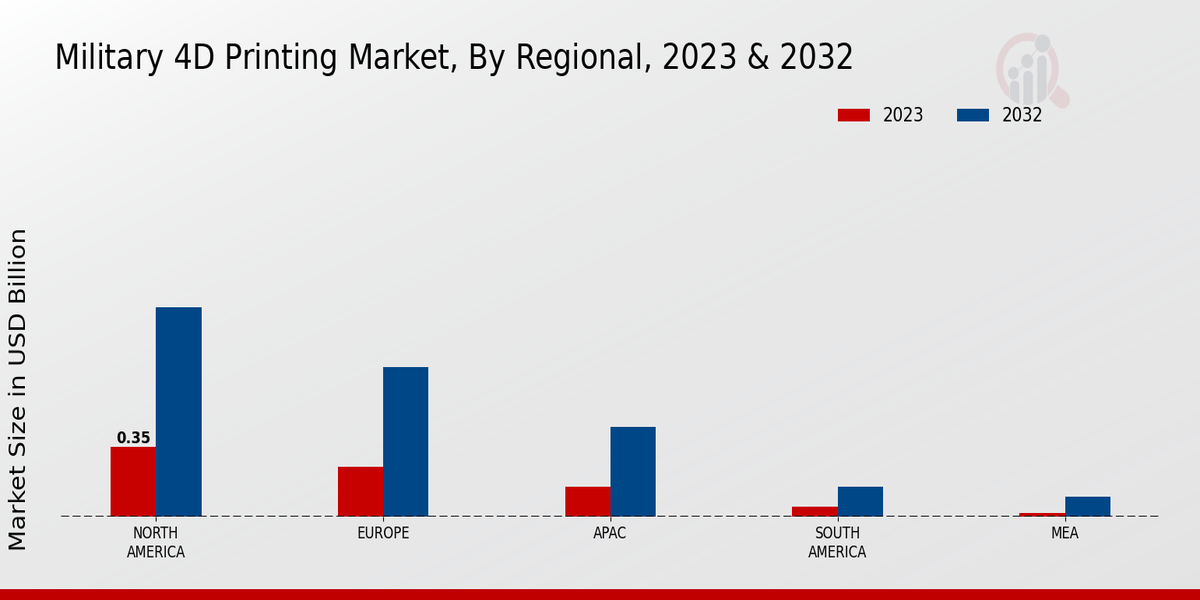Cost Efficiency
Cost efficiency emerges as a pivotal driver within the Global Military 4D Printing Market Industry. By utilizing 4D printing technologies, military organizations can significantly reduce manufacturing costs associated with traditional production methods. The ability to produce on-demand parts minimizes inventory costs and waste, thus optimizing resource allocation. For example, the U.S. Department of Defense has reported substantial savings through the adoption of 3D printing technologies, which are likely to extend to 4D printing. This trend indicates a growing preference for 4D printing solutions, which could lead to a market valuation of 4.07 USD Billion by 2035.
Market Growth Projections
The Global Military 4D Printing Market Industry is anticipated to experience substantial growth, with projections indicating a market value of 1.04 USD Billion in 2024 and an expected increase to 4.07 USD Billion by 2035. This growth trajectory suggests a compound annual growth rate of 13.22% from 2025 to 2035. Such figures reflect the increasing adoption of 4D printing technologies across military applications, driven by factors such as technological advancements, cost efficiency, and the need for customization. The market's expansion is indicative of a broader trend towards innovative manufacturing solutions within the defense sector.
Sustainability Initiatives
Sustainability initiatives are becoming increasingly important within the Global Military 4D Printing Market Industry. The military sector is under pressure to reduce its environmental footprint, and 4D printing offers a pathway to achieve this goal. By minimizing waste and utilizing eco-friendly materials, military organizations can align their operations with global sustainability objectives. For instance, the U.S. Army has initiated programs to explore sustainable manufacturing practices, which may include 4D printing technologies. This focus on sustainability not only enhances the military's public image but also drives innovation, potentially leading to a market valuation of 1.04 USD Billion in 2024.
Technological Advancements
The Global Military 4D Printing Market Industry is propelled by rapid technological advancements in additive manufacturing. Innovations in materials science and printing techniques enable the production of complex structures that can adapt to changing conditions. For instance, the development of smart materials that respond to environmental stimuli enhances the functionality of military equipment. This evolution is expected to contribute to the market's growth, with projections indicating a market value of 1.04 USD Billion in 2024, potentially reaching 4.07 USD Billion by 2035. Such advancements suggest a compound annual growth rate of 13.22% from 2025 to 2035.
Customization and Flexibility
Customization and flexibility are increasingly recognized as vital components of the Global Military 4D Printing Market Industry. The capability to tailor military components to specific mission requirements enhances operational effectiveness. 4D printing allows for the creation of adaptive materials that can change shape or function in response to environmental factors, thereby providing military forces with enhanced versatility. This adaptability is particularly crucial in dynamic combat scenarios, where rapid response is essential. As military organizations continue to seek innovative solutions, the demand for customized 4D printed materials is expected to rise, contributing to a projected market growth of 13.22% CAGR from 2025 to 2035.
Enhanced Supply Chain Resilience
Enhanced supply chain resilience is a critical driver for the Global Military 4D Printing Market Industry. The ability to produce components on-site reduces dependency on traditional supply chains, which can be vulnerable to disruptions. 4D printing enables military forces to manufacture parts in remote locations, ensuring operational continuity even in challenging environments. This capability is particularly relevant in contemporary warfare, where logistics can be a decisive factor. As military organizations increasingly recognize the strategic advantages of localized production, the demand for 4D printing technologies is expected to grow, supporting a projected market growth trajectory.












